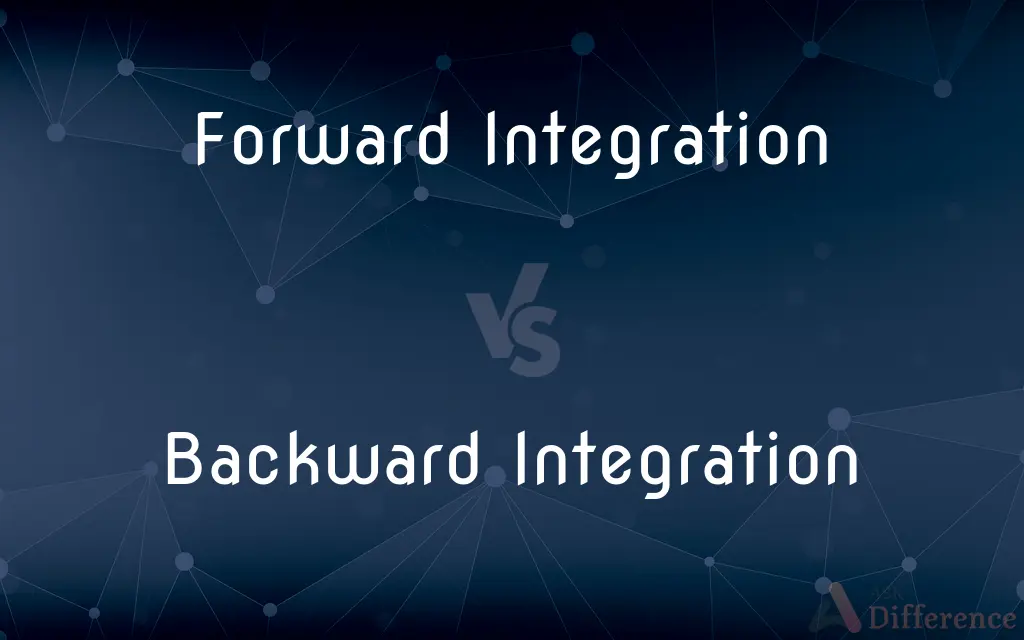Forward Integration vs. Backward Integration — What's the Difference?
By Tayyaba Rehman — Published on January 16, 2024
Forward integration involves a company expanding control over its direct product distribution, while backward integration refers to a company acquiring control over its supply chain.

Difference Between Forward Integration and Backward Integration
Table of Contents
ADVERTISEMENT
Key Differences
Forward integration is a business strategy where a company extends its operations towards the customer end of the supply chain. It often involves companies taking control of the distribution or retail aspects of their business, bringing them closer to the end consumers. Backward integration, conversely, refers to a company moving upstream in the supply chain by acquiring or merging with suppliers. This strategy focuses on gaining control over the production or supply of raw materials.
A typical example of forward integration is a manufacturer starting its own retail outlets to sell its products directly to consumers. This strategy helps in increasing profit margins and having better control over product presentation and customer service. Backward integration, on the other hand, might involve a car manufacturer acquiring a tire company to supply tires for its vehicles. This helps in reducing dependency on suppliers and can lead to cost savings and improved supply chain reliability.
Forward integration allows companies to have direct access to market feedback and control over brand representation. It can lead to enhanced customer experience and loyalty. Backward integration, in contrast, offers companies more control over the quality and cost of the raw materials, ensuring a stable supply and potentially reducing production costs.
The choice between forward and backward integration depends on various factors including the company's core competencies, market conditions, and financial capabilities. Forward integration is often driven by the desire to expand market share and increase direct interaction with customers, while backward integration is motivated by the need for cost control, efficiency in production, and reducing vulnerabilities in the supply chain.
In terms of challenges, forward integration requires expertise in sales and customer service, which might be outside a manufacturer's traditional skill set. Backward integration, meanwhile, can involve challenges in managing production processes of raw materials, requiring a shift in operational focus and capabilities.
ADVERTISEMENT
Comparison Chart
Direction of Expansion
Towards customer end of supply chain
Towards supplier end of supply chain
Typical Examples
Manufacturer starting retail outlets
Manufacturer acquiring a supplier
Benefits
Direct market access, customer loyalty
Cost control, supply chain stability
Focus
Distribution, retail
Raw material sourcing, production
Challenges
Requires retail and customer service expertise
Involves managing raw material production
Compare with Definitions
Forward Integration
Market Feedback Access: Gaining direct market insights.
Forward integration allows the company to receive immediate consumer feedback.
Backward Integration
Production Cost Reduction: Lowering production costs through supply control.
Backward integration helped the company reduce its production expenses.
Forward Integration
Direct to Consumer Sales: Selling products directly to consumers.
By opening its stores, the company forward-integrated to enhance customer experience.
Backward Integration
Quality Control of Materials: Managing the quality of raw materials.
Backward integration allowed the company to maintain high standards in material quality.
Forward Integration
Brand Representation Control: Managing how the brand is presented.
The company uses forward integration to maintain its brand image.
Backward Integration
Control Over Supply Chain: Gaining control of the supply chain.
The company's backward integration ensured a steady raw material supply.
Forward Integration
Control Over Distribution: Taking control of product distribution.
The company's forward integration into retail helps control its market presence.
Backward Integration
Supply Chain Reliability: Ensuring stable input supply.
Through backward integration, the company secured its key inputs reliably.
Forward Integration
Customer Service Management: Overseeing end-customer interactions.
Through forward integration, the company improved its customer service quality.
Backward Integration
Supplier Acquisition: Acquiring suppliers to reduce costs.
By acquiring a raw material supplier, the company achieved backward integration.
Common Curiosities
Why do companies choose backward integration?
To gain control over their supply chain and reduce reliance on suppliers.
Is backward integration suitable for small businesses?
It depends on the business's resources and the complexity of its supply chain.
How does forward integration affect customer experience?
It can enhance customer experience through direct service and feedback channels.
How does forward integration impact brand loyalty?
Direct interaction with customers can lead to stronger brand loyalty.
Is backward integration always beneficial?
Not always; it needs to align with the company's overall strategy and capabilities.
What challenges can arise from forward integration?
Challenges include managing retail operations and customer relations.
Does forward integration require new skill sets?
Yes, it often requires retail and customer service expertise.
How does forward integration affect market feedback?
It allows for quicker and more direct feedback from customers.
What is the main goal of forward integration?
To control the distribution and increase direct interactions with customers.
What are the risks of backward integration?
It can lead to increased operational complexity and capital investment.
Can forward integration help in competitive markets?
Yes, it can provide a competitive edge through direct customer engagement.
What industries commonly use backward integration?
Industries like manufacturing, where control over raw materials is crucial.
Can a company pursue both forward and backward integration?
Yes, some companies integrate both ways for complete supply chain control.
Can backward integration lead to cost savings?
Yes, by reducing the costs associated with external suppliers.
Does backward integration ensure quality control?
It can improve quality control by managing the production of raw materials.
Share Your Discovery

Previous Comparison
LTD vs. LLC
Next Comparison
Chili Pepper vs. Chili PowderAuthor Spotlight
Written by
Tayyaba RehmanTayyaba Rehman is a distinguished writer, currently serving as a primary contributor to askdifference.com. As a researcher in semantics and etymology, Tayyaba's passion for the complexity of languages and their distinctions has found a perfect home on the platform. Tayyaba delves into the intricacies of language, distinguishing between commonly confused words and phrases, thereby providing clarity for readers worldwide.
















































